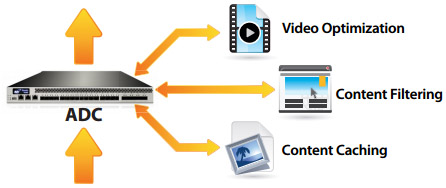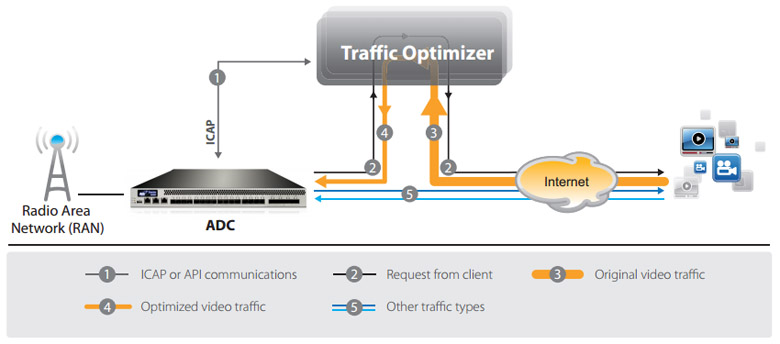
Traffic Steering
Network Optimization for Mobile Networks
Mobile service providers are in constant need of lowering network costs and increasing content control. The Radio Area Network (RAN)—the far edge of the network where all mobile subscribers connect—is one of the most expensive sections of the network. Typically, bandwidth in the RAN is signi cantly oversubscribed; any improvements in the e fficiency of this network segment translate into significant cost savings and an enhanced end-user experience.
Bandwidth reduction is a large motivator; however, there also is need for more control of traffic content. With the ability to control their tra ffic, service providers can provide extra services and generate more revenue. For example, a provider might wish to add parental control, or to inject advertisements into the traffic stream in order to o ffer less expensive subscription packages to customers.
Solutions for Reducing Costs with Intelligent Traffic Control
To e fficiently deploy advanced optimization or content modification solutions that scale with tra ffic growth, the solution should not always be placed in-line with tra ffic. Deploying these solutions in-line can create a bottleneck, markedly diminishing the end-user experience. Not only would such a deployment create unnecessary delays, it could make very ine cient use of the individual optimization solution; resources are wasted when, for example, a video optimizer is presented with non-video traffic. In such a case, the optimizer wastes valuable cycles attempting to optimize inapplicable tra fficc, before determining that the traffic cannot be handled by the optimizer, and at last forwarding it on.
Efficient Traffic Processing with the A10 Thunder and AX Series
A10 Thunder and AX Series give network providers a solution that interacts with speci c traffic modi cation services, based on traffic content. The A10 device can redirect traffic based on its "fingerprint" to the appropriate service for optimization and management of that traffic type. This greatly improves both network e fficiency and the end-user experience.
Video Optimization Use Case
Subscriber traffic is expanding rapidly, driven by both the increasing number of connected devices, and the increasing bandwidth usage per subscriber. The increase in demand for high-bandwidth content such as streaming video exponentially increases the strain on network capacity.
Looking at mobile traffic composition, while video takes up a small portion of the traffic ows, it can take up to 65 percent of the bandwidth. Optimizing video traffic alone can have a very large impact on overall bandwidth usage on the edge of the network. Video traffic can be greatly optimized, and there are several vendors that are very pro cient in reducing the bandwidth usage of a video stream.
Application Delivery Controllers (ADCs) such as A10 Thunder and AX Series can redirect traffic based on content type. The ADC redirects video-related traffic to a video optimizer, for example. This results in very e cient use of the video optimizer solution, and the ADC is able to balance the traffic over multiple appliances, resulting in a highly scalable, high availability solution.
The decision for redirecting traffic is not made solely upon the content; such a decision could, optionally, be made using a more flexible array of variables. The A10 device can be con gured with di fferent policies to make forwarding decisions; for example, it can determine what type of smartphone is connecting, and steer its traffic to a specific optimization device for that smartphone's video resolution.
As another example, if a URI request contains MPEG or youtube.com, the content likely is video. The optimizer may not be able to manage the traffic based on type; or, perhaps the optimizer needlessly uses cycles compressing or over-compressing the traffic when there is no requirement.
Advanced traffic redirection such as this requires an ADC that can interact with an optimization solution through an API interface or using ICAP (RFC 3507).

AX Series with Tra c Steerin
A10's AX Series supports ICAP, which makes it a clear choice for interaction with a controller. It can look at the content type of a URI and, for example, search for the following:
- video/*
- *mpegurl*
- application/smil*
- text/xml
This invokes the AX device to interact with the controller interface of the optimizer solution. If the content is conformed to be video, and needs to be optimized, it will be sent on to the optimizer, resulting in reduced bandwidth usage. Of course the forwarding decision also can be made by local policies that rely on other variables, without ICAP interaction.
Powering the Next Wave of Network Optimization
A10 Thunder and AX Series ADCs are the right solutions for Traffic Steering solutions:
- The 64-bit Advanced Core Operating System (ACOS) enables traffic optimizing solutions to be deployed at scale.
- ICAP support to provide seamless integration with optimizer solutions.
- Pre-filter content based on URI, offloading the optimizer solutions from overhead to increase e fficiency.
- The traffic Steering feature, combined with traffic optimization solutions, greatly increases bandwidth e fficiency in networks.
- Mobile device type detection for advanced traffic steering policies.
With its appliances A10 o ffers extremely powerful traffic steering solutions, providing many business benefits, including:
- Reduced infrastructure cost (RAN).
- Enables advanced services for service provider di erentiation.
- Increased availability and scalability of content management solutions.
A10 Thunder and AX series ADCs come in a wide range of form factors with advanced acceleration options, so each customer can choose the right model for their environment. A10 o ffers unprecedented features, performance, exibility and cost-e fficiency.


